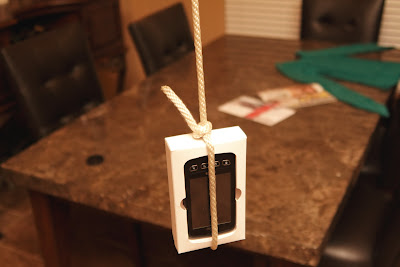 |
| Yes. This is real safe. I blame physics... |
What You'll Need
- Cellphone (preferably an Android or iPhone)
- Snug holster for the phone (original packing materials work fine)
- Rope
- Sound-making app (signal generator app on Android works fine, the mosquito noise that the kids love to use as their ringtone is also great to use)
- Microphone
- Audacity (free download)
- Sonic Visualizer (free download)
- If you've gotten then you can probably guess you'll need a computer
What You Do
Make sure the phone is secure. Yeah, this could really cause problems, especially if you're using your mom's phone (or worse - your mom using your son's phone). You are going to be swinging the phone around your head - I want you to think about that statement before you go any further.
Attach the rope to whatever is snugly wrapped around your phone. I used the original packing material for my cheap Virgin Mobile phone. You can't tell in the picture above, but the rope is woven through a hole so that it is not coming out.
 |
| Signal Generator (Android) |
The rest is rather straightforward from here. Open the signal generator app from your phone and start generating some noise. Now start swinging the phone around. You should immediately hear the Doppler Effect. But what's so special about that? You've done this demonstration a million times before, right?
You know that mosquito ring tone that is so high pitched that you can't even hear it if you are too old? Wait, what's that? Oh, well, there's this high pitch mosquito ring tone that you can't even hear if you are too old. Go ahead and slide the signal generator frequency to 20 kHz. No one in your room (except your dog) will be able to hear this noise.
Before you start swinging your phone around, start recording on your computer with Audacity. As you are swinging this around above your head your students will probably snicker about the lack of sound and how the Doppler Effect doesn't work for inaudible things.
After you have a good several seconds of recording, go ahead and stop Audacity and save the file as a .wav file somewhere on your computer. Open up the Sonic Visualizer program and from there open the .wav file you just created. Then add a spectrogram view by navigating to Pane > Add Spectrogram from the menu bar.
If you look in the right spot (the right spot being near 20 kHz) you should see that good 'ole Doppler Effect, and the students should be pretty amazed.
After the students have seen one spectrogram in Sonic Visualizer they will want to try and make all sorts of sounds and then visualize them. I really like the mosquito noise exercise because it's a great segue into other types of inaudible waves; as an Astronomy teacher that's pretty powerful.
Why Do I like this Activity?
Well first of all, it shows students that a cell phone can be used to create a pretty elaborate physics demonstration on a classical phenomenon. Further, students can't text on a phone that is being swung around their heads.
Go ahead try it! Let me know how it goes...

No comments:
Post a Comment